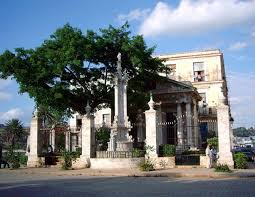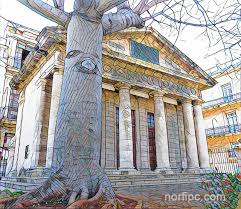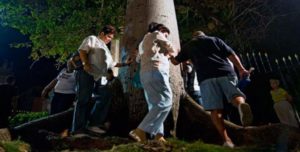LA CEIBA DEL TEMPLETE, EN LA HABANA CONTINUA SIENDO UNA DEIDAD.
La Ceiba es considerada la casa de todos los santos. Es el árbol sagrado de la religión afrocubana, también de los mayas, de los aztecas y de los incas.
Bajo una ceiba, situada a los pies de El Templete — un singular espacio diminuto, de arquitectura neoclásica, donde según se cuenta se celebró el primer cabildo de la ciudad alredor de una planta de la misma especie el 16 de noviembre de 1519, y según la tradición, tambien se celebró la primera misa cuando en esa fecha, La Habana se asentó en ese lugar que ocupa desde entonces, se lleva a cabo una longeva tradicion popular, La Tres vueltas a la Ceiba.
Como una herencia de siglos, cada 16 de Noviembre se dan cita alli los cubanos alrededor de la ceiba para dar tres vueltas en sentido contrario a las manecillas del reloj. La gente la acaricia una y otra vez, como si fuera una deidad. De todas partes de la capital, incluso de otras provincias, los cubanos continúan dando vida a una tradición tan antigua como la propia Villa. Algunos le echan quilos prietos, monedas, pero lo cierto es que hombres, mujeres y niños —silenciosos o no— dejan allí, a su resguardo, confidencias, deseos y aspiraciones.
Cuestiones de salud, ansias de casamiento o de viajes, y hasta solución de conflictos maritales u otros personales se le “piden” a este árbol de gran significación para algunas religiones, que en las de origen africano representa a Iroko*.
LEYENDAS, CREENCIAS E HISTORIAS.
En siglos pasados algunos historiadores la consideraron “apócrifa”. Tal fue el caso del patriota villareño Antonio Miguel Alcover. Segun Alcover.. “los cubanos no debían reverenciar este supuesto árbol bajo cuya sombra “se habrían arrodillado, sin fe ni sentimientos nobles, algunos sátrapas de los que, como Tacón, Balmaceda y Weyler, pisaron y ensangrentaron nuestro suelo”.
Otros enfoques de la ceiba y el monumento de El Templete han existido. No obstante, el sabio etnólogo cubano Don Fernando Ortiz, según narra la literatura consultada, ofreció un giro radical en las creencias que se tenían hasta esos momentos.
En su opinión, contraviniendo a la tradición que prevalecía desde José Martín Félix de Arrate y Acosta (considerado como el primer historiador cubano), el simbolismo de la ceiba no era eminentemente religioso. “Creemos que la ceiba del Templete —afirmó categórico— fue el emblema de la municipalidad de la villa de la Habana y el más antiguo y permanente emblema de libertades ciudadanas que conservamos en Cuba”.
NUEVA CEIBA Y ANTIGUA TRADICION.
Desde entonces ha llovido mucho, más la tradición se mantiene, no solo por quienes practican alguna religión sino por todos aquellos que siembran sus esperanzas en que las tres vueltas, los deseos y el dinero depositado en sus raíces puedan dar resultados.
Cada 16 de noviembre —fecha en que se fundó San Cristóbal de La Habana— el lugar es visitado por cientos de personas, que no siempre esperan la medianoche para realizar el ritual, y desde horas tempranas del día hacen sus ruegos con el propósito de evitar las aglomeraciones y las largas colas.
Pero apenas hace unos años una brigada de la empresa constructora Puerto Carenas, de la Oficina del Historiador de la Ciudad retiró en la mañana del martes 9 de febrero la ceiba que ya llevaba 56 años en el sitio, debido a su marcado deterioro por los estragos del comején.
Según se cuenta, la primera de estas ceibas murió a mediados del siglo XVIII, y a partir de entonces tales ejemplares han sido reemplazados varias veces desde que el gobernador el capitán Francisco Cagigal de la Vega (ortodoxo y profanador de monumentos históricos) mandara a cortar la primigenia.
Hoy en El Templete, la ceiba todavía no muy frondosa por su “juventud”, vive la sembrada apenas unos años — luego de haber sido desenterrada la anterior—, continuará siendo sin dudas todo un ícono de la ciudad maravilla, a la cual le han cantado los más inspirados poetas y compositores.
Ahí están las ‘Sábanas Blancas’ de Gerardo Alfonso, un genuino canto a esta ciudad, que tampoco dejó a un lado el árbol mítico: “Habana, mi gran habana/Costumbre de darle una vuelta a la ceiba de noche/Y fiestas en casas de barrios modernos y pobres/de gente noble…”
El Templete y la herencia popular de los deseos a la ceiba original ya cumplieron 500 años, ambos son uno de los monumentos más visitados por cubanos y extranjeros. Parece que así ha sido siempre.
LA CEIBA DEL TEMPLETE, IN HAVANA CONTINUES TO BE AN INHERITED DEITY.
La Ceiba is considered the house of all saints. It is the sacred tree of the Afro-Cuban religion, also of the Mayas, the Aztecs and the Incas.
Under a kapok tree, located at the foot of El Templete — a singular tiny space, of neoclassical architecture, where according to the accounts the first city council around a plant of the same species was held on November 16, 1519, according to tradition The first mass was also celebrated there when, on that date, Havana settled in the place it has held since then a long-standing popular tradition is carried out, La Tres Vuelta a la Ceiba..
As a legacy of centuries, every November 16 Cubans gather around the ceiba to make three turns in a counterclockwise direction. People caress her over and over again as if she were a deity. From all over the capital, even from other provinces, Cubans continue to give life to a tradition as old as Villa itself. Some throw tight kilos, coins, but the truth is that men, women, and children – silent or not – leave confidences, desires, and aspirations there.
Health issues, longing for marriage or travel, and even the resolution of marital or other personal conflicts are “asked” from this tree of great significance for some religions, which in those of African origin represent Iroko *.
LEGENDS, BELIEFS, AND STORIES.
In past centuries some historians considered it “apocryphal”. Such was the case of the Villarian patriot Antonio Miguel Alcover. According to Alcover … “the Cubans should not revere this supposed tree under whose shadow” some satraps would have knelt, without faith or noble feelings, of whom, like Tacón, Balmaceda and Weyler, stepped on and bloodied our soil. ”
Other approaches to the ceiba and the El Templete monument have existed. However, the wise Cuban ethnologist Don Fernando Ortiz, according to the literature consulted, offered a radical turn in the beliefs that were held until then.
In his opinion, contrary to the tradition that prevailed since José Martín Félix de Arrate y Acosta (considered as the first Cuban historian), the symbolism of the ceiba tree was not eminently religious. “We believe that the Ceiba del Templete,” he stated categorically, “was the emblem of the municipality of the town of Havana and the oldest and most permanent emblem of civil liberties that we preserve in Cuba.”
NEW CEIBA AND ANCIENT TRADITION.
Since then it has rained a lot, but the tradition continues, not only for those who practice any religion but for all those who sow their hopes that the three turns, the wishes and the money deposited in their roots can give results.
Every November 16 – the date on which San Cristóbal de La Habana was founded – the place is visited by hundreds of people, who do not always wait for midnight to perform the ritual, and from early hours of the day make their prayers in order to avoid crowds and long lines.
But just a few years ago, a brigade from the construction company Puerto Carenas, from the City Historian’s Office, withdrew on the morning of Tuesday, February 9, the ceiba tree that had already been on the site for 56 years, due to its marked deterioration due to the devastation of termite.
According to accounts, the first of these ceiba trees died in the mid-eighteenth century, and since then such specimens have been replaced several times since the Governor, Captain Francisco Cagigal de la Vega (Orthodox and desecrator of historical monuments) ordered to cut the primeval.
Today in El Templete, the ceiba tree still not very leafy due to its “youth”, lives the planted just a few years – after the previous one was unearthed -, it will undoubtedly continue to be an icon of the wonder city, which has been sung by the most inspired poets and composers.
There are the ‘White Sheets’ by Gerardo Alfonso, a genuine song to this city, which did not leave aside the mythical tree either: “Havana, my great Havana / Custom of giving a tour of the ceiba tree at night / And house parties of modern and poor neighborhoods / of noble people … ”
The Templete and the popular inheritance of the wishes to the original ceiba have already completed 500 years, both are one of the most visited monuments by Cubans and foreigners. It seems that it has always been so.
Agencies/ RHC/ Alina M. Lotti /Ciro Bianchi/ Maria Calvo/ Internet Photos/ Arnoldo Varona/ www.TheCubanHistory.com
THE CUBAN HISTORY, HOLLYWOOD.














